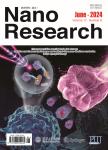Aqueous self-assembly and surface-functionalized nanodots for live cell imaging and labeling
Aqueous self-assembly and surface-functionalized nanodots for live cell imaging and labeling作者机构:Department of Chemistry and Center for Nanoscience and Nanotechnology 'National Sun Yat-sen University' Kaohsiung 80424 School of Pharmacy College of Pharmacy Kaohsiung Medical University Kaohsiung 80707
出 版 物:《Nano Research》 (纳米研究(英文版))
年 卷 期:2014年第7卷第8期
页 面:1164-1176页
核心收录:
学科分类:1304[艺术学-美术学] 13[艺术学] 080503[工学-材料加工工程] 08[工学] 0804[工学-仪器科学与技术] 0805[工学-材料科学与工程(可授工学、理学学位)] 0802[工学-机械工程]
基 金:Ministry of Science and Technology [NSC 101-2113-M-110-013-MY3, NSC 101-2811-M-110-034, NSC 102-2811-M-110-008] "National Sun Yat-sen University" Center for Nanoscience and Nanotechnology
主 题:atomic force microscop hydrophilicity molecular imaging self-assembly silane
摘 要:Nanoparticles have enormous potential for bioimaging and biolabeling applications, in which conventional organically based fluorescent labels degrade and fail to provide long-term tracking. Thus, the development of approaches to make fluorescent probes water soluble and label cells efficient is desirable for most biological applications. Here, we report on the fabrication and charac- terization of self-assembled nanodots (SANDs) from 3-aminopropyltriethoxysilane (APTES) as a probe for protein labeling. We show that fluorescent SAND probes exhibit both bright photoluminescence and biocompatibility in an aqueous environment. Selective in vitro imaging using protein and carbohydrate labeling of hepatoma cell lines are demonstrated using biocompatible SANDs conjugated with avidin and galactose, respectively. Cytotoxicity tests show that conjugated SAND particles have negligible effects on cell proliferation. Unlike other synthetic systems that require multistep treatments to achieve robust surface functionalization and to develop flexible bioconjugation strategies, our results demonstrate the versatility of this one-step SAND fabrication method for creating multicolor fluorescent probes with the tailored functionalities, effident emission, as well as excellent biocompatibility, required for broad biological use.



